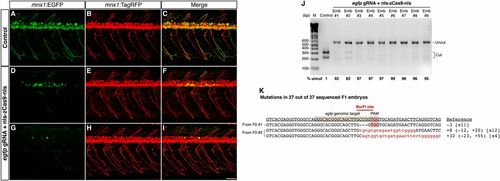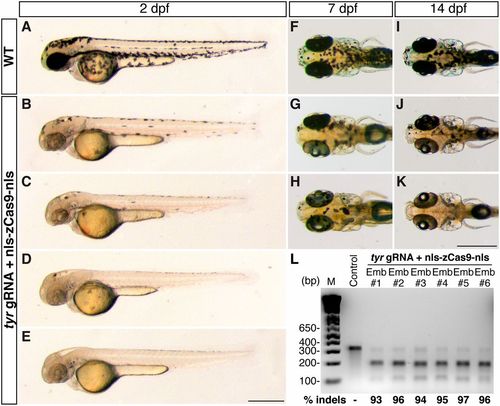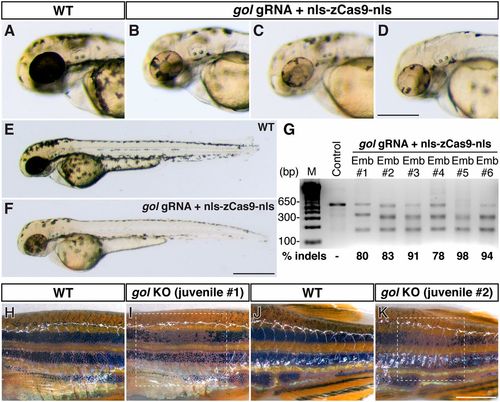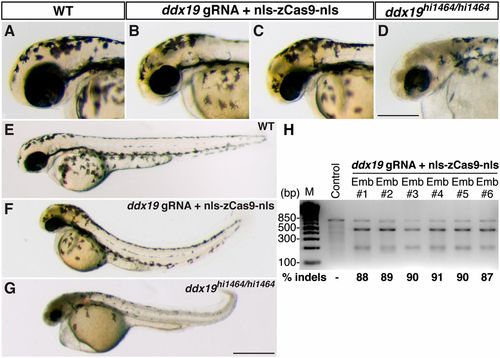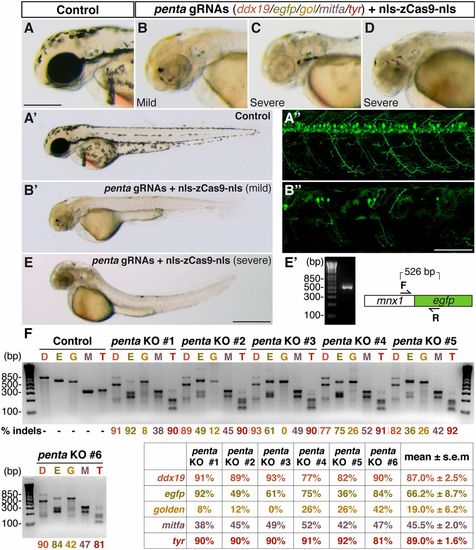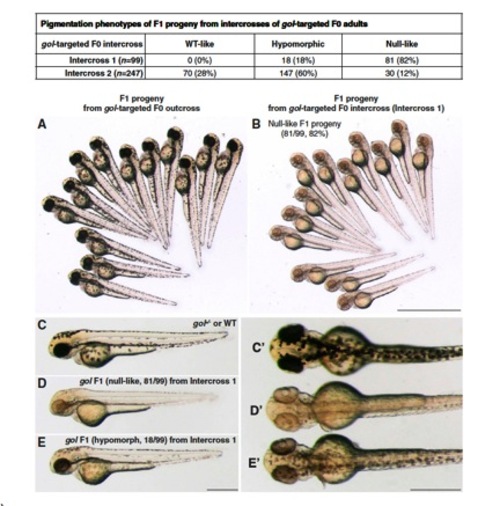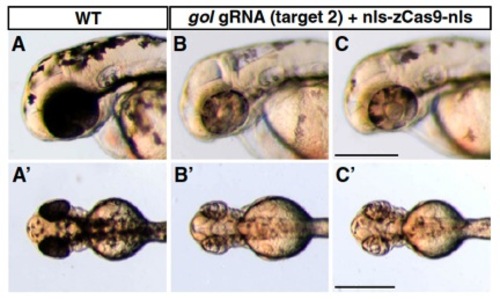- Title
-
Efficient multiplex biallelic zebrafish genome editing using a CRISPR nuclease system
- Authors
- Jao, L.E., Wente, S.R., and Chen, W.
- Source
- Full text @ Proc. Natl. Acad. Sci. USA
|
Efficient disruption of the Tg(-5.1mnx1:EGFP) transgene by Cas9 results in mosaic EGFP expression in the motoneurons. egfp gRNA (6 or 30 pg) and nls-zCas9-nls RNA (150 pg) were injected into Tg(-5.1mnx1:EGFP)/Tg(-5.1mnx1:TagRFP) double transgenic embryos. The control embryos were injected with nls-zCas9-nls RNA and a gRNA lacking the egfp target sequence. (A?I) Confocal images of spinal motoneurons of live zebrafish embryos at 3 dpf. In contrast to the uniform motoneuron EGFP expression pattern in the control (A), egfp-targeted embryos showed mosaic EGFP expression in the motoneurons (D and G). However, the motoneurons of the egfp-targeted embryos developed normally as indicated by the uniform TagRFP labeling (E and H). (J) BsrFI digestion showed high mutagenesis rates at the egfp target site (82?99%) in nine randomly selected egfp-targeted embryos. (K) Sequences of egfp mutations in 27 F1 embryos from two egfp-targeted Tg(-5.1mnx1:EGFP)-positive founders. The wild-type reference sequence is underlined with the target site and PAM highlighted in gray and red, respectively. Note that all 27 F1 siblings had egfp mutations with the BsrFI site (marked by a red line) disrupted. Deletions and insertions are indicated by dashes and lowercase red letters, respectively. The net change of each indel mutation is noted at the Right of each sequence (+, insertion; ?, deletion). The number of times a mutant allele was identified is indicated in brackets. (Scale bar: 50 μm.) |
|
Biallelic disruption of tyrosinase (tyr) by Cas9 generates mosaic pigmentation phenotypes. tyr gRNA (30 pg) and nls-zCas9-nls RNA (150 pg) were injected into wild-type embryos. (A?E) Lateral views of wild-type (A) and tyr-targeted embryos (B?E) at 2 dpf. tyr-targeted embryos showed different degrees of hypopigmentation, some of them were almost unpigmented (e.g., E). (F?K) Dorsal view of the wild-type (F and I) and tyr-targeted larvae (G, H, J, and K) at 7 dpf (F?H) and 14 dpf (I?K). Mosaic pigmentation defects in tyr-targeted larvae persisted to later stages. (L) T7EI assays showed high mutagenesis rates at the tyr target (93?97%) in six randomly selected tyr-targeted embryos. (Scale bars: 500 μm.) PHENOTYPE:
|
|
Biallelic disruption of golden (gol) by Cas9 generates mosaic pigmentation phenotypes. gol gRNA (50 pg) and nls-zCas9-nls RNA (150 pg) were injected into wild-type embryos. (A?F) Lateral views of wild-type (A and E) and gol-targeted embryos (B?D and F) at 2 dpf. Whereas the wild-type embryo showed darkly pigmented retinal pigment epithelium (RPE), gol-targeted embryos had patches of unpigmented cells in RPE (B?D). The skin melanophores in gol-targeted embryos were also hypopigmented (F). (G) T7EI assays showed high mutagenesis rates at the gol target (80?98%) in six randomly selected gol-targeted embryos. (H?K) Lateral views of wild-type (H and J) and gol-targeted (I and K) juvenile fish at 54 dpf. gol-targeted fish had patches of pale melanophores (dashed boxes) among the dark skin stripes. (Scale bars: in D, 300 μm; in F, 500 μm; in K, 2 mm.) PHENOTYPE:
|
|
Biallelic disruption of ddx19 by Cas9 generates null-like phenotypes. ddx19 gRNA (150 pg) and nls-zCas9-nls RNA (150 pg) were injected into wild-type embryos. (A?G) Lateral views of the wild-type (A and E), ddx19-targeted (B, C, and F), and homozygous ddx19 mutants (ddx19hi1464/hi1464 ) (D and G) embryos. ddx19-targeted embryos recapitulated several ddx19 null phenotypes (e.g., brain necrosis, small eyes, and curved body axis), albeit to a lesser extent. (H) T7EI assays showed high mutagenesis rates at the ddx19 target (87?91%) in six randomly selected ddx19-targeted embryos. (Scale bars: in D, 300 μm; in G, 500 μm.) PHENOTYPE:
|
|
Multiplex genome editing in zebrafish by Cas9. A mix of five gRNAs (penta gRNAs: ddx19 gRNA, 55 pg; egfp gRNA, 15 pg; gol gRNA, 25 pg; mitfa gRNA, 60 pg; and tyr gRNA, 25 pg) were coinjected with nls-zCas9-nls RNA (150 pg) into Tg(-5.1mnx1:egfp) transgenic embryos. (A?E) Lateral views of the wild-type (A?A22) and the penta gRNAs/nls-zCas9-nls RNA-injected (B?B22 and C?E) embryos. The combination of three distinct phenotypes?brain necrosis/small eyes/curved body axis, hypopigmentation, and loss of EGFP expression in the motoneurons?caused by biallelic inactivations of multiple target genes simultaneously were observed in the same embryos (B?B22 and E and E2). Some quintuple knockout embryos showed no EGFP-positive motoneurons due to the almost nonmosaic disruption of the Tg(-5.1mnx1:egfp) transgene, whose presence was confirmed by PCR (E2). (F) T7EI assays showed high mutagenesis rates at five genomic targets in six randomly selected quintuple knockout embryos (penta KO 1?6: D, ddx19; E, egfp; G, gol; M, mitfa; T, tyr). (Scale bars: in A, 300 μm; in B22, 50 μm; in E, 500 μm.) |
|
Germ-line transmission of Cas9-induced mutations at the gol locus. (A?E) Two pairs of gol-targeted founders were intercrossed (intercross 1 and intercross 2) to generate F1 progeny. At 2 dpf, 81 of 99 (82%) F1 embryos from intercross 1 were phenotypically null (B, D, and D2) and the rest 18 of 99 (18%) F1 embryos were hypopigmented (E). Lack of F1 progeny with wild-type pigmentation suggested that the germ line of both gol-targeted founders from intercross 1 had <100% biallelic disruption of gol loci. In intercross 2, 72% of the F1 progeny were either null-like or hypopigmented, indicating that the majority of the gol loci in the germ line of these two founders was also biallelically disrupted. (F) Sequences of the gol target region of 12 F1 progeny (6 nulllike, 6 hypopigmented) from intercross 1. All sequences (33 of 33) had indels near the gol target. Because only 10 different gol mutant alleles were recovered from 12 F1 siblings and 7 of these 10 alleles were recovered multiple times, the germ line of each gol-targeted founder from intercross 1 likely had only limited numbers of gol mutant alleles. Note that all of the null-like F1 progeny had either a frameshift or a nonsense mutation at both gol alleles, whereas all of the hypopigmented F1 embryos had either a 6 or a +3 small in-frame indel in one of the gol alleles. ND, not determined. (G) Screening five gol-targeted founders by outcrossing followed by T7EI assays to detect gol mutations in the F1 progeny. All five gol-targeted founders transmitted gol mutations to their progeny as indicated by the presence of two expected T7EI fragments. |
|
Biallelic disruption of golden (gol) by Cas9 targeting a second location at the gol locus (gol target 2) generates similar mosaic pigmentation phenotypes. gol gRNA (gol target 2) (50 pg) and nls-zCas9-nls RNA (150 pg) were injected into wild-type embryos. Lateral (A?C) or dorsal (A2?C2) views of wild-type (A and A2) and gol-targeted embryos (B?C2) at 2 dpf. Whereas the wild-type embryo showed darkly pigmented retinal pigment epithelium (RPE), gol-targeted embryos had patches of unpigmented cells in RPE. The skin melanophores in gol-targeted embryos were also hypopigmented. The phenotypes were indistinguishable from those generated by the other gol-targeted gRNA shown in Fig. 4. (Scale bars: in C, 300 μm; in C2, 500 μm.) |

